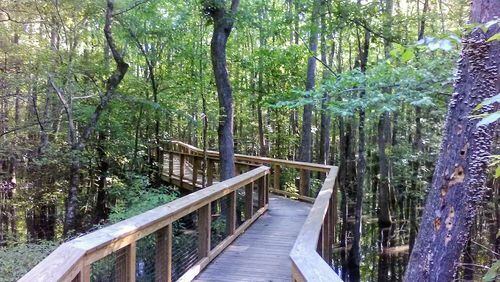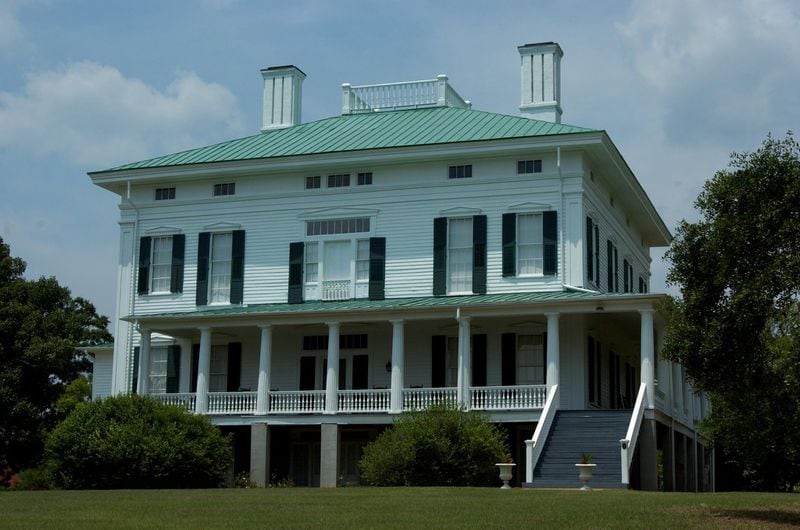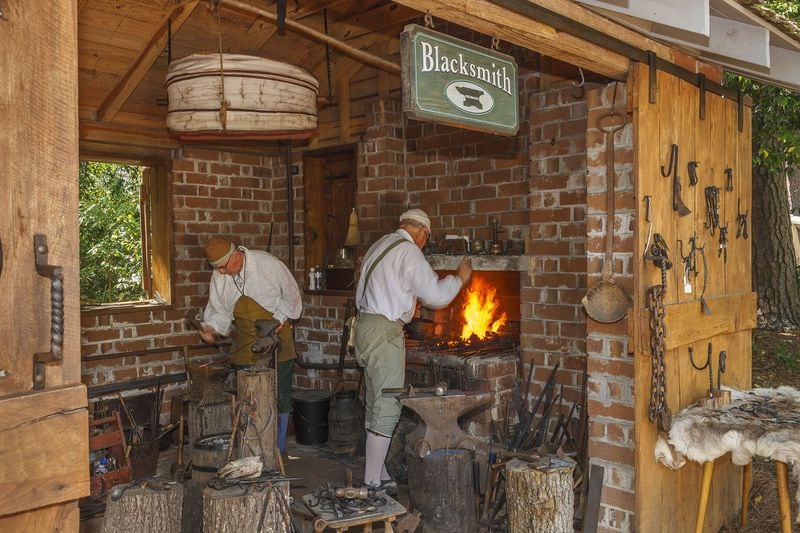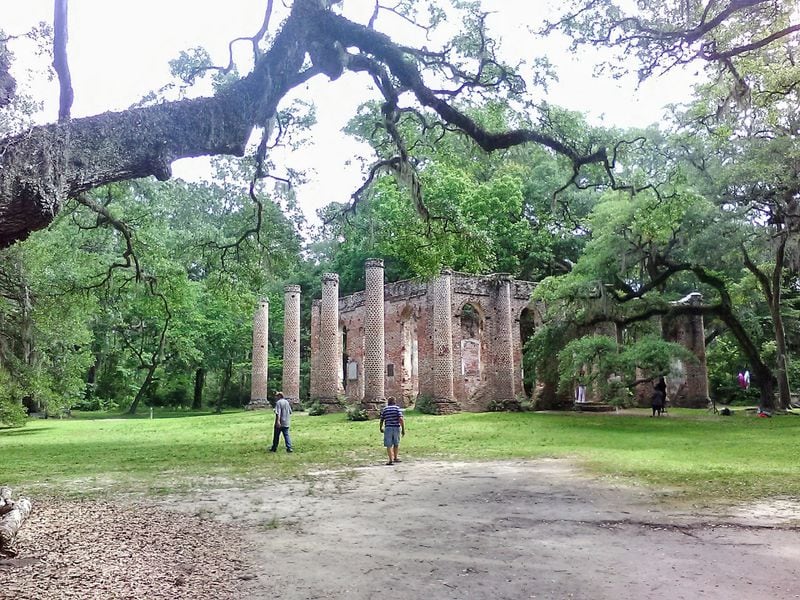There’s a lot more to South Carolina’s history than Fort Sumter in Charleston Harbor, where the first shots of the Civil War were fired. Here are some of the lesser-trafficked and off-the-tourist-radar historical sites, including some natural and living history, from the Lowcountry to the Upstate and points in between.
Natural history at Congaree
One of the closest national parks to Atlanta is South Carolina’s Congaree National Park, 3.5 hours from downtown. Located outside Columbia in the central part of the state, it’s a newer park to the system, established in 2003 to protect the largest remaining stand of old-growth bottomland hardwood forest in the country. You’ll find many champion trees here, meaning they are the largest of their species. The average height of the tree canopy is 100 feet, with some trees topping out closer to 170 feet. Much of the South used to look like Congaree does today before the old-growth forests were decimated by heavy logging practices. For the best overview, head out on the park’s popular 2.4-mile Boardwalk Loop Trail. This wheelchair-accessible elevated boardwalk begins in a younger section of forest on a bluff and circles through the old-growth bottomland portion, so there’s no backtracking. Shorter loops and much longer ground-level trails into the backcountry are also in the park. Check in at the visitor center before hiking to find out trail conditions; since much of the park is in a floodplain, the trails often flood, even the lower portion of the boardwalk trail. Plan at least two hours for the full boardwalk trail, making time to stop at all the numbered points of interest along the way (explained in the trail brochure available at the visitor center). Other activities in the park include camping (two campgrounds and primitive sites available) and canoeing on the Congaree River and tributary creeks (rent gear from outfitters in Columbia).
Congaree National Park, 100 National Park Road, Hopkins. 803-776-4396, www.nps.gov/cong/.
Historic Columbia Foundation
House museums are a dime a dozen, it seems, but the ones under the stewardship of the Historic Columbia Foundation have set themselves apart with their attention to authentic details big and small. If you want more than a glimpse into what life might have been like for slaves, servants and the aristocracy of bygone eras in Southern American life, visit the house museums operated by the foundation. The Robert Mills House was designed by the same architect as the Washington Monument. He despised visible staircases in the foyer, so it’s tucked away to the side in this house. Atlantans will be interested in learning that the Columbia Theological Seminary in Decatur gets its name from its former location in South Carolina’s capital city and this house was once a part of it. Across the street, the Hampton-Preston Mansion, one of the oldest homes in the city, has an original Canaletto in the corner of one room. The gardens outside are expansive and immaculate. Two blocks away, the Mann-Simons Site preserves the place where one African-American family lived and worked from 1843 until 1970, and the Woodrow Wilson Family Home where the 28th president once lived now serves as a museum dedicated to the Reconstruction era. The foundation also provides self-guided walking and driving maps of the city’s neighborhoods, including a fascinating one on Main Street.
Historic Columbia Foundation, 1616 Blanding St., Columbia. 803-252-1770, www.historiccolumbia.org.
Redcliffe Plantation State Historic Site
Armchair historians will delight at the treasure-trove of history awaiting them at Redcliffe Plantation State Historic Site. The site provides a view into the everyday life on a giant Southern plantation without glossing over the troubling parts. The difficult history of slavery is tackled head-on here. In fact, it can’t be avoided due to the vast amount of documentation available from the generations of families who lived and toiled here. The original owner — James Henry Hammond, a former South Carolina governor and senator and the man who coined the phrase “cotton is king” — kept copious notes and diaries that include the warts-and-all history of the place. State park rangers give guided tours of the home Thursdays-Mondays for $7.50, but the rest of the bucolic 369-acre grounds are free to explore. There are paintings in the main home that haven’t been moved off the wall since the house was built in the late 1850s. Don’t miss the old driveway lined with giant magnolia trees, now a walking trail.
Redcliffe Plantation State Historic Site, 181 Redcliffe Road, Beech Island. 803-827-1473, southcarolinaparks.com/redcliffe.
Living History Park
Just up the road from Redcliffe in North Augusta, S.C., the Living History Park awaits those who want to experience what life was like in Colonial times. This isn’t a historic site, but it sure looks like one. Everything here is done like it was during the Colonial period of U.S. history. Most structures in the 7.5-acre park were built using the same methods used in the 1700s and have no electricity or running water even though they’ve been built since the park was founded in 1991. There are an old-time apothecary and a blacksmith shop on-site, and many interpretive history events occur throughout the year. The next big event is Colonial Times: A Day to Remember Oct. 20-22, but smaller events happen on a regular basis. Admission to the park and all events is free.
Living History Park, 299 W. Spring Grove Ave., North Augusta. 803-279-7560, www.colonialtimes.us.
Heart of the Lowcountry
All of downtown Beaufort and its surrounding neighborhoods are part of a National Historic District. Beaufort was founded as an English settlement in 1711, but Spanish settlements existed in the area much earlier.
Surrounded by water on three sides, Beaufort makes a great base of operations for exploring the heart of the Lowcountry. Across the bridge on St. Helena Island, the 50-acre campus of the Penn Center, established in 1862 as one of the first schools for freed African-American slaves, is also a National Historic District. The buildings scattered around the property are shaded by old-growth oaks dangling Spanish moss. The Rev. Martin Luther King Jr. is said to have penned a portion of his “I Have a Dream” speech in one of the cabins when he was in residence here. The York W. Bailey Museum ($7 admission) chronicles the important history of the center and the Gullah culture of the region.
Another don’t-miss site that’s easy to miss is the Old Sheldon Church ruins along Old Sheldon Church Road 16 miles outside of Beaufort. The photogenic ruins of this church built in the mid-1700s stand as a beautiful and haunting shell surrounded by twisted trees and scattered grave sites along a sun-dappled two-lane road. Bring a camera.
Penn Center, 16 Penn Center Circle W., St. Helena Island. 843-838-2432, www.penncenter.com.
IN OTHER NEWS:









